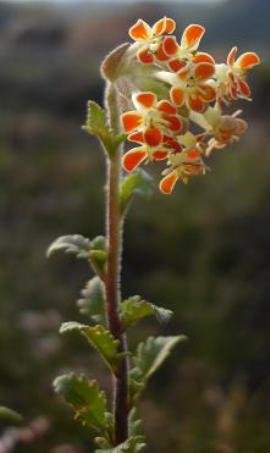Glumicalyx

Author: Ivan Lätti
Photographer: Judd Kirkel Welwitch
Glumicalyx is a genus of perennial herbs and dwarf subshrubs in the Scrophulariaceae or snapdragon family. The plants vary from 6 cm to 60 cm in height and are woody at the base. Several of the species were earlier classified in the Zaluzianskya genus. The plants have leafy stems bearing glandular hairs that point down or backwards on the stems.
The simple leaves are opposite low down on the plants and sometimes alternate higher up. They may be stalkless, partly stem-clasping, joined in pairs or narrowing at the base to nearly having petioles. The leaf-shape is oblong, elliptic or oblanceolate. The leaf margins are mostly toothed. The blades may be leathery or fleshy, sometimes gland-dotted or glandular haired. Some species grow leaves also directly from the ground.
The flowers grow in compact, head-like spikes from stem-tips, the spikes often cone-shaped or globose and nodding. The inflorescences elongate and become erect when fruiting. There are broad bracts below the calyces on the pedicels, different from the leaves and free from the calyx. The five thin-textured, hairy calyx lobes are unequal and sometimes split to or near the base on one side. The calyces appear glume-like, giving the genus its Glumicalyx name. A glume is the bract or leaf-like structure below spikelets in the inflorescences of grasses and the flowers of sedges.
The nearly white to cream corollas are hairless with cylindrical to slightly funnel-shaped tubes of variable length and slightly two-lipped with five spreading or reflexed, rounded or oblong lobes. These lobes are coloured cream, yellow or red in various shades on the inner or upper surfaces, ironically often facing down as the inflorescences nod.
There are four stamens in two pairs of different length in each flower. In some species only one pair is exserted. The filaments arise from high up in the corolla tube. There is a nectary at the base of the superior ovary. The ovaries each has two locules containing at least seven ovules, in some species many. The stigma is flat and tongue-shaped with two exserted marginal bands of stigma papillae.
The fruit is a hairless capsule that splits per locule. The seeds are red brown and angular.
There are six species of Glumicalyx, all growing in southern Africa. The plants are concentrated in Lesotho and nearby South African regions of the Drakensberg Alpine Floral Centre and the Malutis, primarily on basaltic rock.
The plant in picture may be Glumicalyx nutans (Springer, 2019: The role of pollinators as ecological drivers of diversification in the Drakensberg Mountain Centre endemic genus Glumicalyx (Scrophulariaceae, Limoselleae), University of the Witwatersrand; Manning, 2009; Leistner, (Ed.), 2000; Pooley, 1998).

